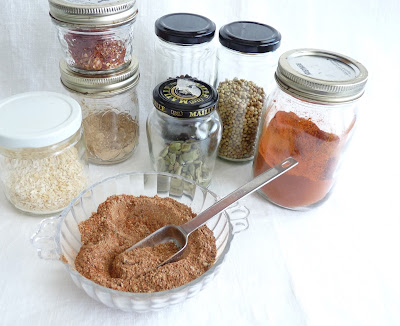We love Ethiopian food, but you can't get it around here, no surprise. Quite a few of the usual ingredients are also impossible to get. I've been thinking of trying to make an Ethiopian meal for a while, but up until now I've been put off by my inability to get certain things. I still can't get them, but I guess I have reached the stage where I am willing to forge ahead anyway and live with the less-than-perfect results. So, over the next 2 weeks I'm going to post recipes for our Ethiopian feast. Several of them start with the spice blend known as berbere, so here's a recipe for that.
Berbere traditionally contains rue seed. That's ruta chalepensis, which I have never seen. It looks, from the photos, very similar to ruta graveolens which is occasionally grown in gardens for its attractive lobed blue-green leaves. It's a member of the citrus family, oddly enough, and like citrus it is supposed to repel cats. I think it did keep cats out of my flower beds when I grew it. I frankly thought it had a very unpleasant odour, and it is a byword in bitterness. I see a lot of recipes on the internet don't even mention it. So, okay.
That's a lot of carrying-on about an ingredient that isn't in this recipe. In spite of the fact that it's a traditional ingredient in Ethiopian cooking, I'm not at all sure I've ever had any food which contained it - it sounds like it would be very distinctive to say the least - so I decided to let it go and not worry about it. I couldn't get the ajwan either, but that's a reasonably common ingredient in Indian and Middle Eastern cooking, and it should be available in more civilized locales.
Even without the rue, making berbere is a pungent experience. If you can set up a burner outside to do it, so much the better. And if you are in a place where you can actually buy pre-made berbere - well, go for it!
All the recipes I use in this set will lean heavily on a book called "Taste of Ethiopia - The Other Good Food" by Webayehu Tsegaye, although as always, I fiddle with them. Even when I don't know what I'm doing.
about 1/4 cup
20 minutes prep time
1/4 teaspoon whole cloves
1/2 teaspoon (about 12 pods) cardamom
1 teaspoon coriander seeds
1/2 teaspoon black peppercorns
1 teaspoon ajwan seeds (IF you can get them)
1 tablespoon dehydrated onion
1 tablespoon ground cayenne OR dried red chile (cayenne) flakes
1 tablespoon sweet Hungarian paprika
1 tablespoon ground ginger
2 teaspoons rubbed basil
It is best to measure everything in advance and have it all standing by. Make this in a well-ventilated area, (*cough* outside *cough*).* Crush the cardomom pods and remove the husks before you get started.
Heat a small skillet over medium heat. Toast the cloves, cardamom, coriander, peppercorns, and ajwan until they begin to be fragrant. Add the dehydrated onions, cayenne and paprika, mix in well, and immediately tip everything out onto a plate to cool.
Put the cooled spices and everything else remaining (the paprika, ginger and basil) into a spice grinder and grind well. If you don't have one, grind the toasted spices first in a mortar and pestle. Sift, re-grinding the bits that don't go through the first time, then mix with the remaining spices. I actually used the "dry" attachment for my Vitamix, and that worked well.
When your berbere is made, keep it in a small, air-tight jar in a cool, dark spot until you are ready to use it.
Last year at this time I made Baked Beans with Garlic, Lemon & Rosemary.
*cough... cough, cough. Cough. Sputter, choke. Cough.
skip to main |
skip to sidebar
Archives
Dining Spots
(8590)
International Recipes
(4549)
Indian Cook
(3756)
Mixed
(3341)
Food Photography
(2558)
Ontario Food
(821)
Video Recipes
(807)
Cupcakes
(715)
International Dishes
(547)
Dessert Ideas
(363)
Indianapolis Restaurants
(333)
Kids Recipes
(218)
Christmas Recipes
(101)
Veg-Recipes
(95)
Home-Cooked
(41)
Mom's Kitchen
(14)
Moms Kitchen
(5)
Popular Posts
-
Below are some of the biggest restaurant and food-related news stories that have been posted between December 29, 2025, and January 4, 2026....
-
A suburban location of a local group of upscale Italian steakhouses has shut down. According to a source, Davio's Northern Italian Stea...
-
A New York-based group of shops featuring bubble tea, smoothies, and juices has closed another one of its Boston-area locations. According ...
-
A second location of a restaurant known in part for its pizza has debuted after being in the works for nearly a year. According to an artic...
-
A coffee shop in the western suburbs of Boston will soon be joined by another location by the city's waterfront. According to a message...
-
A Thai restaurant in Boston that was known for its buffet has shut down after being in business for approximately a year and a half. Accord...
-
A local business known in part for its ice cream that opened in Brighton a few months ago is now closed, but it will be relocating to Cambri...
-
The company behind a now-closed location of a Shanghainese soup dumpling restaurant will be opening a new dining spot in its space. Accordi...
-
A new Mediterranean restaurant is on its way to the southwest suburbs of Boston. According to a press release, MEZŌ is planning to open in ...
-
It looks like a new sushi spot is on its way to Cambridge. According to a poster within the Friends of Boston's Hidden Restaurants Fa...
Powered by Blogger.
Copyright © 2011 Simple Delicious Food Recipes | Powered by Blogger


 04:49
04:49
 Unknown
Unknown


 Posted in:
Posted in:
0 comments:
Post a Comment